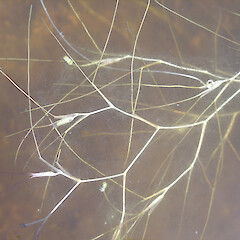Ruppia megacarpa
Common name
Horses mane weed, lakeweed
Synonyms
None
Family
Ruppiaceae
Flora category
Vascular – Native
Endemic taxon
No
Endemic genus
No
Endemic family
No
Structural class
Herbs - Monocots
NVS code
The National Vegetation Survey (NVS) Databank is a physical archive and electronic databank containing records of over 94,000 vegetation survey plots - including data from over 19,000 permanent plots. NVS maintains a standard set of species code abbreviations that correspond to standard scientific plant names from the Ngä Tipu o Aotearoa - New Zealand Plants database.
RUPMEG
Chromosome number
2n = 20
Current conservation status
The conservation status of all known New Zealand vascular plant taxa at the rank of species and below were reassessed in 2017 using the New Zealand Threat Classification System (NZTCS) – more information about this can be found on the NZTCS website. This report includes a statistical summary and brief notes on changes since 2012 and replaces all previous NZTCS lists for vascular plants.
Please note, threat classifications are often suggested by authors when publications fall between NZTCS assessment periods – an interim threat classification status has not been assessed by the NZTCS panel.
- Conservation status of New Zealand indigenous vascular plants, 2017 . 2018. Peter J. de Lange, Jeremy R. Rolfe, John W. Barkla, Shannel P. Courtney, Paul D. Champion, Leon R. Perrie, Sarah M. Beadel, Kerry A. Ford, Ilse Breitwieser, Ines Schönberger, Rowan Hindmarsh-Walls, Peter B. Heenan and Kate Ladley. Department of Conservation. Source: NZTCS and licensed by DOC for reuse under the Creative Commons Attribution 4.0 International licence.
2017 | At Risk – Naturally Uncommon | Qualifiers: RR, SO
Previous conservation statuses
2012 | At Risk – Naturally Uncommon | Qualifiers: RR, SO
2009 | Not Threatened
2004 | Not Threatened
Distribution
Indigenous. North, South and Chatham Islands. Present in Australia
Habitat
Saline ponds, lagoons and slow flowing brackish streams. Predominantly coastal but occasionally extending inland
Wetland plant indicator status rating
Information derived from the revised national wetland plant list prepared to assist councils in delineating and monitoring wetlands (Clarkson et al., 2021 Manaaki Whenua – Landcare Research Contract Report LC3975 for Hawke’s Bay Regional Council). The national plant list categorises plants by the extent to which they are found in wetlands and not ‘drylands’. The indicator status ratings are OBL (obligate wetland), FACW (facultative wetland), FAC (facultative), FACU (facultative upland), and UPL (obligate upland). If you have suggestions for the Wetland Indicator Status Rating, please contact: [Enable JavaScript to view protected content]
OBL: Obligate Wetland
Almost always is a hydrophyte, rarely in uplands (non-wetlands).
Detailed description
Rhizome undistinguished; stems rather long usually with abundant zigzag branching. Leaves (40–)100–150(–200) × (0.2–)0.4–0.5(-0.7) mm, bright to olive green, almost filiform but broad-oblong in cross-section; apex bidentate, often most minutely denticulate; sheath (10–)15–25(-40) mm long, auriculate. Peduncles to 0.3 m long, usually reddish, scarcely thicker below flowers, becoming spirally coiled as fruit matures. Flowers protandrous; carpels 4, occasionally 5–6 in upper flower. Podogynes stout, tapering towards base. Achenes 40–45(–50) mm long, gibbous, olive-green, sometimes red-punctate; mesocarp thick; endocarp tuberculate, black, with 2 triangular apertures opposite to and about on level of top of operculum; beak c.1.3 mm long.
Similar taxa
Ruppia polycarpa differs from R. megacarpa by its curved to straight rather than zig-zagged branching pattern, obtuse rather than bidentate leaf apices; carpels usually 4 per flower (rather than (5-)8(-16)), and fruits which are 4-5 mm long rather than < 3 mm long. Stuckenia pectinata which sometimes grows with both species of Ruppia is superficially similar. It is easily distinguished from both Ruppia species by the ligulate acute-tipped leaves, tuberous stems, and spicate inflorescences.
Flowering
October - February
Fruiting
November - April
Propagation technique
Uncertain. Probably easily grown in suitable conditions but Ruppia is unlikely to be widely cultivated (if at all). Most people regard it as a pest and are only interested in eradicating it.
Etymology
ruppia: Named after Heinrich Bernhard Ruppius (1689-1719), an 18th century German botanist
Where To Buy
Not commercially available
Attribution
Fact sheet prepared for NZPCN by P.J. de Lange 2 March 2011. Description adapted from Moore & Edgar (1970).
References and further reading
Moore, L.B.; Edgar, E. 1970: Flora of New Zealand Vol. II. Wellington, Government Printer.
NZPCN Fact Sheet citation
Please cite as: de Lange, P.J. (Year at time of access): Ruppia megacarpa Fact Sheet (content continuously updated). New Zealand Plant Conservation Network. https://www.nzpcn.org.nz/flora/species/ruppia-megacarpa/ (Date website was queried)






